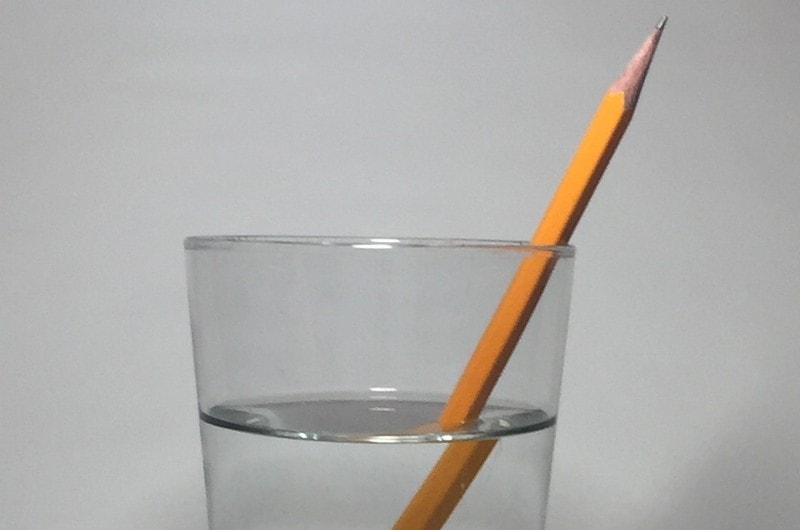What Is the Refractive Index of Water? Uses, Factors, & FAQ
Last Updated on

The refractive index shows the bending of light when it passes from one medium to another. For example, the refractive index of water is 1.33. It means the speed of light is 1.33 times faster in a vacuum than in water.
A material’s refractive index imparts two significant effects on light: total internal reflection and dispersion. Its speed changes when a ray of light passes from one medium to another. The angle at which the beam of light hits the boundary between the two mediums also affects its speed. As a result, the ray of light bends.
The bending depends on the difference in the refractive indices of the two mediums. Let’s learn more about the refractive index and how it affects the properties of materials.

How Does Refractive Index Work?
The principle of refractive index is based on comparing the speed of light in a specific medium to a vacuum. Light rays bend when moving from one medium to another due to the speed of light.
It happens because when light passes into a different medium, the medium’s atoms absorb and emit light constantly. As a result, the speed of light is always the same in a vacuum, but it slows down when it passes through another medium.
The refractive index is calculated by dividing the speed of light in a vacuum by the speed of light in a medium. Here’s the formula:
Refractive Index = speed of light in a vacuum / Speed of light in the medium
Besides speed, light also changes direction from one medium to another. That’s where Snell’s law comes in.
Snell’s law is a mathematical formula that describes how light bends when it moves from one medium to another. The law calculates the angle of refraction, which is the angle between the light ray and the normal line.
The angle of incidence refers to the angle between the light ray and the normal line in the first medium. Meanwhile, the angle of refraction is the angle between the light ray and the normal line in the second medium.
- Speed of light in both mediums
- Angle of incidence
- Angle of refraction
- Refractive indices of both mediums
It’s possible to calculate the refractive indices of all types of materials. Some examples include fine powder, emulsions, turbid suspensions, and transparent or colored solutions.

Which Factors Affect the Value of the Refractive Index?
When calculating the refractive index, it’s important to consider light wavelength and temperature. Both of these factors can impact the value of the refractive index.
Temperature
At a higher temperature, a liquid medium is less viscous and denser. As a result, light travels faster in it. Due to this, the refractive index has a smaller value since the ratio is small too.
The liquid medium is more viscous and less dense when the temperature is low. In this case, light travels slower, and the refractive index has a higher value.
Wavelength of Light
The wavelength of light also impacts the refractive index because every wavelength interferes with the medium’s atoms to various extents. Therefore, you should use monochromatic light to prevent light dispersion into multiple colors.
When calculating the refractive index, choose a wavelength the medium does not absorb. For example, most refractometers work with a wavelength of 589 nm (sodium D) because they are easy to produce and are not absorbed by many common materials.

Types of Refractive Indices
In most cases, we assume that linear equations determine refraction. However, specific subsections of refraction do not always follow this rule. Different types of refractive indices help us better understand how light bends.
Birefringence
Birefringence refers to the splitting of a ray of light into two beams when it passes through certain materials, such as calcite. It is also known as double refraction because it essentially creates two images from one object.
The two rays are known as ordinary and extraordinary rays. The phenomenon occurs because the two rays have different refractive indices. While the ordinary ray has a refractive index determined by the average of the two refractive indices, the extraordinary ray’s refractive index depends on the difference between the two refractive indices.
In this case, the refractive index of the medium will depend on the light’s propagation direction and polarization. The concept is also called optical anisotropy.
Crystals are birefringent naturally. But you can also introduce birefringence in glass, plastics, and other isotropic materials by providing an external electric field or force. The process, called photoelasticity, can relieve structural stress in the media.
Nonlinearity
Nonlinear optics describe the behavior of light when it interacts with materials whose refractive index changes with intensity. The Kerr effect is a nonlinear optical phenomenon that causes the refractive index of a material to increase when exposed to an intense light beam.
Kerr nonlinearity is used in different applications, such as all-optical signal processing and data storage. The effect can also be used to create extremely short laser pulses.

Anomalous Dispersion
Anomalous dispersion occurs when the refractive index of a medium decreases with increasing frequency. It is the opposite of normal dispersion, where the refractive index increases with frequency.
Anomalous dispersion is responsible for chromatic aberration in lenses. It occurs because each light color is bent by a different amount when it passes through a lens. The result is that the colors are not focused on the same point. Anomalous dispersion can also create ultrafast laser pulses.
Inhomogeneity
The gradient index optics define any material whose refractive index changes with position. The material is called GRIN or gradient-index material.
When light travels through this medium, its propagation direction is constantly changing. It happens because each point in the medium has a different refractive index.
An excellent example of this is the human eye lens. It has a refractive index varying from 1.406 to 1.386. The difference in refractive indices helps the eye focus light on the retina.

Where Is the Refractive Index Used?
There are quite a few applications of refractive index. Every optical instrument has a lens, and the bending of light by a lens is determined by its refractive index.
The amount of bending is given by the ratio of the sine of the angle of incidence to the sine of the angle of refraction. Therefore, the refractive index helps determine a lens’s focusing power. Here are some other uses of refractive indices.
Determines a Prism’s Dispersive Ability
Prisms can be used to split white light into a spectrum of colors. The refractive index determines the amount of dispersion (the degree to which the colors are separated).
Like diamonds, materials with a high refractive index produce a strong dispersion. Meanwhile, some have a low refractive index, like glass, creating a weak dispersion.
A fiber optic cable comprises two materials with different refractive indices. Light enters one end and is reflected off the boundary between the materials. This is how information can be sent long distances through the cable.
Gives an Estimate of a Substance’s Purity
The refractive index can give you an estimate of how pure a liquid is. For example, water has a refractive index of 1.333.
If you take a sample of pure water and add impurities, the refractive index will increase. The more impurities you add, the more significant the change in the refractive index.
However, the method is not foolproof because the type of impurity can affect the refractive index. For example, adding table sugar (sucrose, which has a refractive index of 1.474) will cause a more notable increase in the refractive index than adding salt (sodium chloride) to the same volume of water (salt has a refractive index of 1.544). Therefore, the change in the refractive index is not always proportional to the concentration of impurities.
Establishes the Identity of a Substance
The refractive index can also help to identify a substance. For example, oils have a lower refractive index than water. So, if you shine a light through an unknown liquid sample with a refractive index lower than water, you can be reasonably sure that the liquid is an oil.
There are online databases that list the refractive indices of many common substances. You can use them for media identification.

Measures Solute Concentration in Aqueous Solutions
When a non-volatile solute is added to water, the refractive index of the solution changes predictably. The difference is directly proportional to the solute concentration.
Therefore, if you know the solution’s refractive index and the solvent’s identity (water), you can determine the concentration of the solute. The method is commonly used in biochemistry and molecular biology to measure protein concentrations.
It should be noted that the method is not limited to aqueous solutions. It can be used for any liquid where the change in refractive index with solute concentration is known.
There are a few disadvantages to using the refractive index to measure solute concentration. For one, it’s not very accurate. The measurements are usually only good to about +/- 0.001 refractive index units (RIU).
Another disadvantage is that it only works for solutions with a relatively low solute concentration. At high concentrations, the change in the refractive index becomes nonlinear.
Differentiate Between Gemstones
All gemstones have a unique chatoyance. It refers to how light reflects off the stone’s surface to create a shimmering effect. The refractive index of the stone determines the chatoyance.
For example, diamonds have a high refractive index (2.417) and a strong dispersive ability. It produces a brilliant chatoyance. Opals have a lower refractive index (1.37) and don’t disperse light as much. As a result, they have a more subdued chatoyance. The refractive index can help identify which gemstone you’ve found.
Determine the Quality of Liquids
The method is common in the food and beverage industry to measure the purity of honey and fruit juices.
The higher the refractive index, the purer the liquid is. For example, pure honey has a refractive index of 1.474 and 1.504.
Let’s say you use honey in your food business. If you measure its refractive index and it’s pretty far from the published value, that indicates impurities. Therefore, you can use the refractive index to determine the quality of honey and other liquids.

How Is the Refractive Index Measured?
A refractometer is a device used to measure a medium’s refractive index (RI). There are many models of refractometers, but they all work on the same principle.
A liquid sample is placed on a glass plate, and light is shone through it. The angle at which the light is refracted (bent) is measured, and the RI is calculated from this.
The most common type of refractometer is the Abbe refractometer. It was invented in the 19th century and is still widely used today. Other kinds of refractometers include the Becke line refractometer and the Seidel refractometer.

Frequently Asked Questions (FAQs)
What Is Water’s Refractive Index Greater Than 1?
The refractive index of water is bigger than one because the velocity of light in a vacuum is greater than that of light in water. The refractive index measures the bending of light as it passes from one medium to another.
Is There a Unit of Refractive Index?
There is no specific unit of refractive index, but it is typically measured in terms of the speed of light. For instance, water’s refractive index is 1.33. So, there’s no unit in front of it.
How Does a Medium’s Density Affect Refractive Index?
The denser the medium, the higher its refractive index. A high-density material will slow down the speed of light passing through it. As a result, the refraction index will be higher. For example, a diamond is denser than water. So, the speed of light is slower in diamonds than in water. As a result, diamonds’ refractive index is higher than water’s.
Why Is Refractive Index Important?
The refractive index shows the amount of bending that occurs when light passes from one medium to another. It is an essential property because it determines how much light is bent when it passes through a medium. For instance, a lens with a higher refractive index will bend light more than a lens with a lower refractive index. These properties of materials help determine their applications.

Summing Up
You can calculate a material’s refractive index by finding the ratio of the speed of light in a vacuum compared to the speed of light in that material. The refractive index can help find the angle of incidence, the angle of refraction, and the Fresnel equations. It is also useful in many other fields, such as optics, medicine, and engineering.
See also:
- What Is the Refractive Index of Glass? (Full Breakdown!)
- What Is the Refractive Index of Air? Everything You Need to Know!
Featured Image Credit: ScienceGiant, Pixabay
About the Author Jeff Weishaupt
Jeff is a tech professional by day, writer, and amateur photographer by night. He's had the privilege of leading software teams for startups to the Fortune 100 over the past two decades. He currently works in the data privacy space. Jeff's amateur photography interests started in 2008 when he got his first DSLR camera, the Canon Rebel. Since then, he's taken tens of thousands of photos. His favorite handheld camera these days is his Google Pixel 6 XL. He loves taking photos of nature and his kids. In 2016, he bought his first drone, the Mavic Pro. Taking photos from the air is an amazing perspective, and he loves to take his drone while traveling.
Related Articles:
Binocular Magnification Chart: Numbers & Distances Compared
What Is the Best Binocular Magnification for Hunting? Optical Features Explained
When Were Binoculars Invented? History, Today & Future
How to Clean a Refractor Telescope: Step-by-Step Guide
How to Clean a Telescope Eyepiece: Step-by-Step Guide
How to Clean a Rifle Scope: 8 Expert Tips
Monocular vs Telescope: Differences Explained (With Pictures)
What Is a Monocular Used For? 8 Common Functions
